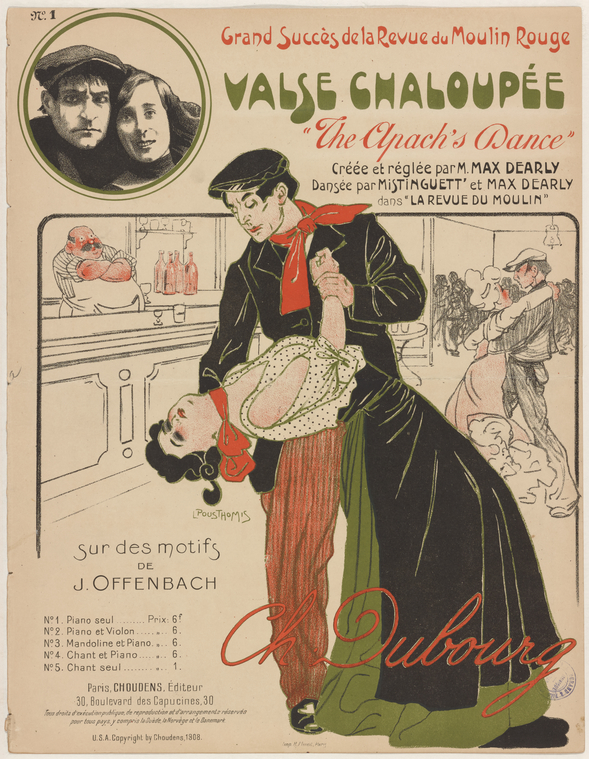
This post takes a deeper dive into the commonly used adjectives in the June 1908 coverage of the Steinheil Affair discussed here. There will be fewer visualizations and/or exciting uses of algorithms; instead, I concentrate on two things: how the initial reporting would have been read as a story about class and how we can see signs of doubt emerging among reporters (and the general public) on June 2, the second day of reporting on the affair.
Good vs. bad, rich vs. poor, beautiful vs. ugly
As we’ve seen, the earliest coverage of the affair often focused on physicality. Yet in both the June 1 and June 2 articles, the physical descriptions were not neutral and instead many combined moral and aesthetic judgements, ones that established clear distinctions between the beautiful, innocent elite victims and the ugly and base perpetrators. For instance, across these two sets of articles, the term “coquet,” which meant elegant or stylish appears 10 times. (“Coquettement,” the adverbial form, appears twice, as well.) All but one instance of “coquet” described the spaces in which the Steinheils lived, either their house on impasse Ronsin (in the fifteenth arrondissement of Paris) or their home in Meudon, just outside of the city. Likewise, there is “joli” (pretty), which appears 8 times (“joliment,” or prettily, is used once); these words were also used to describe Mme Steinheil, her daughter Marthe, or their residences.
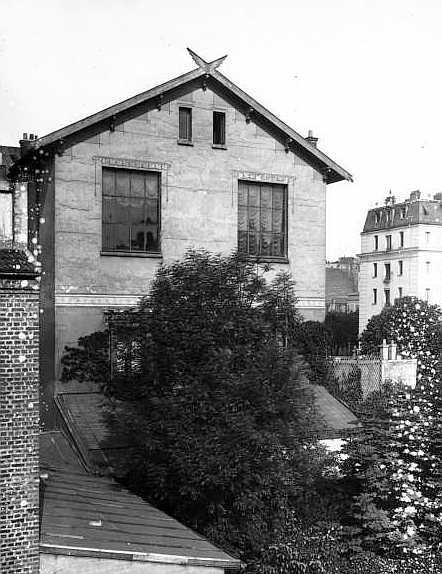
If we look at these words in context, they frequently served to situate Mme Steinheil and/or her household in elite milieus. Take three examples:
- Le Figaro, June 1: one of Mme Steinheil’s friends said of her: “C’est une femme ravissante, jolie. Artiste dans l’âme, musicienne de talent, elle aimait à recevoir dans son hôtel les meilleurs musiciens.” (“She is a delightful, pretty woman. An artistic soul, a talented musician, she loved to receive the best musicians in her house.”)
- Le Petit Parisien, June 1: another friend of the family told reporters that Mme Steinheil was “Jolie, intelligente, et douée d’une fort jolie voix, elle obtenait de grands succès dans la société belfortaise où sa famille était reçue.” (“Pretty, intelligent and gifted with a very pretty voice, she found great success in the society of Belfort [her home region], where her family was received.”)
- Le Temps, June 2: “Très élégante, d’une beauté rare, Mme Steinheil est une musicienne de talent. Elle donnait souvent dans l’hôtel de l’impasse Ronsin des soirées qui avaient un grand succès.” (“Very elegant, unusually beautiful, Mme Steinheil is a talented musician. She frequently hosted successful soirées in her house on the impasse Ronsin.”)
In all cases, Mme Steinheil’s physical attributes were linked to her success in high society and her salon gatherings, in particular.
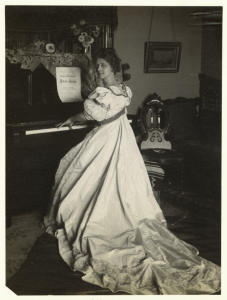
In contrast, the adjectives describing the criminals’ appearances often convey ugliness. “Roux” (redheaded) appears 7 times in June 1 and 28 times on June 2; as discussed earlier, red hair was not seen as attractive at the time, but was regarded as a sign of a woman’s low moral and class standing. Or take the word “osseux” (bony), which is hardly a flattering term, and which was used for one of the alleged male robbers-turned-killers five times in the June 2 articles. Likewise, the term “sale” (dirty) was used 6 times on June 2 to describe the criminals in some way.
Another set of commonly used adjectives located these individuals in a particular social and moral space. They were cast as being “misérable” (which translates to contemptible, wretched or destitute) 7 times on both June 1 and June 2 or described as “vulgaire” 2 times on June 1 and 5 times on June 2. This last term was frequently used within the context of the phrases “vulgaires cambrioleurs” (common thieves) or “vulgaire criminels” (common criminals), but the term “vulgaire” also means vulgar or coarse. In other instances, the criminals were said to belong to the “basse pègre” (a phrase that appears twice in these articles) or labeled as “apaches” (used three times on June 2). These terms referred to essentially the same thing: the Parisian underworld. The phrase “basse pègre” had a long been used to describe the criminal classes in the nineteenth century, but the term “apaches” had only recently come into circulation in the years before the Steinheil Affair to refer to Parisian gangsters. They were imagined to be young men and women who could work, but who chose a life of violent banditry instead; Le Petit Parisien spoke of them as being in an “insurrectional state against society.” Many of them lived on the periphery of Paris, a zone of crime, poverty and ill-repute. The origins of this term to refer to members of the criminal underworld speaks to the perception that these individuals both rejected civilization and lived on its fringes. Although few French people at the time had direct knowledge or contact with Native Americans, many had been raised on American adventure tales that depicted Apaches as particularly violent and resistant to European-American settler expansion and/or “civilizing” efforts.
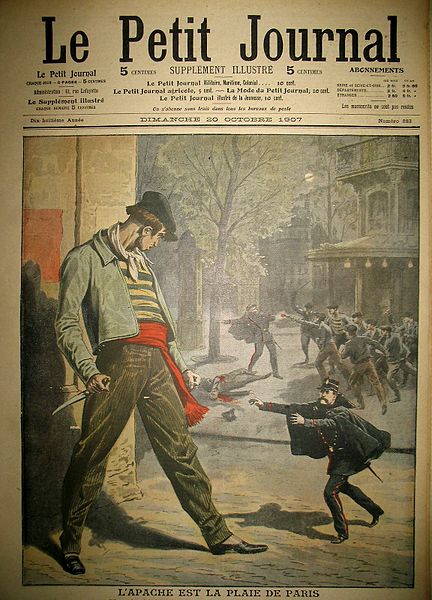
Accordingly, these articles reflected much of the received wisdom about who criminals were. Take the following statement from June 2 in Le Journal: “Les propos répétés par la femme de l’artiste tendent à démontrer que les misérables, mal vêtus, parlant l’argot le plus crapuleux, appartiendraient au monde de la ‘basse pègre.’” (“The many remarks of the wife of the artist aim to show that the badly dressed wretches, who spoke the basest slang, belong to the underworld.”) For Mme Steinheil, reporters and readers, the supposed criminals were to be regarded with revulsion as figures who rejected the sartorial and linguistic norms of polite society. Behind this claim was also the idea that it was the poor who broke the law. Hence, both social status and adherence to rules of behavior were highly legible, visible on the very body itself.
Taken together, these statements about the Steinheils on the one hand and the supposed murderers on the other illustrate a particular view of the social hierarchy that was common at the time. Respectable society was under threat from those on the bottom rungs of the social ladder; the double-murder was just one example of the horrific violence that was so common in Paris in the 1900s. At the same time as these ideas proposed that the good people of Paris were in danger, they also served to naturalize and legitimate the existence of a stratified and deeply inegalitarian society. Elites were beautiful and good; the poor were ugly, dirty, evil and criminal. The social world was simple and individuals could easily distinguish between the low and the high, the bad and the good.
Doubt creeps in
And yet, perhaps it wasn’t so simple…
Just as journalists were stressing, either through their own language or through quotations from others, a fixed view of French society in general and the double-murder in particular, they also expressed doubt on the veracity of Mme Steinheil’s account. Yet they did so in subtle ways and recognizing all the signs of doubt would have required close attention on the part of readers.
The existence of doubt should hardly be surprising; as discussed in earlier, Mme Steinheil’s account made no sense. In the June 2 articles, readers were treated to the first of her many inconsistencies. She had initially claimed that one of the criminals was one of her husband’s models; now, she was sure that they were complete strangers to the household. Members of the public could easily imagine why an artist’s model knew the details of his house, as the murderers seemed to, or even why he would have dressed in wild costumes, but it was less comprehensible why unknown common criminals would have. Meg was perhaps wary of providing positive identifications of the criminals; such a plan might backfire if they had an alibi and, at this point, she may have been reluctant to place individuals she knew in jeopardy. It was far safer to say that she had never seen her attackers. In any case, any lies or inconsistencies could be explained by gender. At the time, many women (including Mme Steinheil) were diagnosed as hysterics and thus prone to lying and/or exaggerated claims. Who could blame her for telling untruths and changing her story in the wake of a traumatic event?

But perhaps she did have something to hide. On June 2, newspapers revealed that the family’s home in Meudon (where Mme Steinheil’s daughter Marthe was staying the night of the murder) had been rented in the name of Mme Prévost and that when the Steinheils stayed there, they called themselves the Prévosts. Why use a fake name? This was surely suspicious. (As members of the public would later learn, this house was where Mme Steinheil entertained her lovers there. She had used a friend’s name to rent the house to keep nosy neighbors from knowing that such a notorious woman was living near them.)
Mme Steinheil and the terrible, horrible, no good, very bad days
The emergence of doubt about Mme Steinheil’s account and her character is visible if we look at a subtle shift in adjectives. In particular, on June 2, the crime began to be described as “terrible” instead of merely “horrible.”

At its origin, the double-murder was regarded as horrible, not terrible. But over the course of the affair, and especially after November 1908, when Mme Steinheil became the chief suspect, “terrible” took over from “horrible” as a way to describe the events of the night of May 30/31, 1908. The coverage on June 2 represents an interesting moment, for while there are many more mentions of “horrible” (18) than “terrible” (7), the latter term begun to creep into the vocabulary of the affair.
Both words describe things that are bad, but they don’t mean quite the same thing. Notably, terrible, unlike horrible, can be used for something that that is inexplicable, mysterious, powerful and beyond the human realm. (This is true in English, as well and in the King James Bible, Psalm 47:2 reads “For the LORD most high is terrible; he is a great King all over the earth.” Obviously, here, terrible is less a synonym for awful than for awesome.)
To categorize the Steinheil Affair as “terrible” was to imply that there was a larger mystery to the crime. This wasn’t just an ordinary, run-of-the-mill murder at the hands of common criminals, but had something to do with forces that were powerful and hidden. Given that Mme Steinheil was closely connected to many politicians and high state officials (and associated with the death of one of them), using this term may have suggested that the crime was related to her life as a mistress to the rich and powerful. In other words, this slight change in language was a way to indicate that the reading public should have doubts about her account.
Questioning Mme Steinheil’s version
Or, take the issue of when and how question marks appear in the June 1908 articles. Of course, question marks appear in dialog, as in transcripts of interviews with Mme Steinheil or the authorities investigating the crime. But reporters also used them for other reasons. Journalists could employ them to write their articles in a more dramatic fashion (think about the difference between the following two ways of saying the same thing: “Next, she said that it was midnight” and “What did she say next? That it was midnight.”) Frequently in the coverage of the Steinheil Affair, they could convey a reporter’s own doubts: how could this possibly be true?
Not only were this types of question marks (i.e., those not in dialog but that a reporter inserted) more common on June 2 than June 1 (appearing 31 times as opposed to 15), they were also used to a very different effect on these two days. On the first day of reporting on the case, journalists often employed them to indicate that the mysteries of the crime would soon be resolved. Hence, Le Petit Parisien asked: “Peut-être même Mme Steinheil…pourra-t-elle, maintenant que la terreur folle dans laquelle elle se trouvait est un peu calmée, préciser ses souvenirs et mettre un nom sur le visage de celui des hommes qui pénétra dans sa chambre pour l’assassiner?” (“Perhaps Mme Steinheil … can, now that the mad terror in which she found herself has calmed, recall her memories and put names to faces of the men who came into her room to murder her?”) This was a way of saying that if initial account was beyond belief, once she regained her senses, it would undoubtedly become less so and the killers would be found. (Unsurprisingly, one exception is L’Humanité. Even on June 1, they used question marks to cast doubt on Mme Steinheil’s statements; as discussed earlier, this paper was skeptical of her claims from the beginning.)
However, on June 2, such questions marks were often used to indicate doubt or that all was not as it seemed. For instance, Le Radical stated the following about the veracity of Mme Steinheil’s account: “Et, fait-on remarquer aussi, pourquoi ont-ils apporté tant de complications dans l’exécution de leur triple forfait? Pourquoi leur bourrer la bouche avec de l’ouate, pourquoi les étrangler avec avec des cordes, pourquoi toute cette mise en scène inutile et dangereuse, alors que ces misérables étaient pourvus de couteaux et de revolvers?” (“And, we can also ask, why did they [the criminals] bring so many complications in the execution of their triple crime? Why should they stuff their mouths [i.e., those of Mme Steinheil and Mme Japy] with cotton wadding, why strangle with ropes, why all this useless and dangerous staging, when these wretches had knives and revolvers?”) Likewise, Le Petit Journal asked “Pourquoi, en effet, réserver la vie de cette troisième personne, la seule qui pouvait les accuser tous?” (“Why, indeed, save the life of this third person [i.e., Mme Steinheil], the only one who could accuse them all?”)
Or, take how Le Figaro used such question marks in its June 2 article on the affair: “On pose les questions les plus étonnantes: Pourquoi les cris d’appel n’ont-ils pas été plus tôt entendus? Pourquoi n’y a-t-il pas de traces de lutte dans la maison…? Pourquoi cette ouate? Pourquoi cette corde? Pourquoi? Pourquoi?” (“The most astonishing questions are being asked: Why were the cries for help not heard earlier? Why are their no signs of struggle in the house…? Why this cotton Why this cord? Why? Why?”) (Ellipses in original. Here, the author was referring to the fact that the wadding used to gag Mme Steinheil and her mother and the cord used to strangle M. Steinheil and his mother-in-law had come from inside the house and had not been brought by the criminals.) But, the author stated, “Ce jeu nous semble vain et cruel” (“This game strikes us as useless and cruel”) and it should be the police, not the public and reporters, who investigated the crime. And yet, by the very fact of asking these questions – even as saying they shouldn’t be asked – Le Figaro was pointing to the many troubling contradictions in Mme Steinheil’s account.
And yet, few journalists were willing to foreground their doubts. This is visible if we look at where these types of question marks appear in the articles.
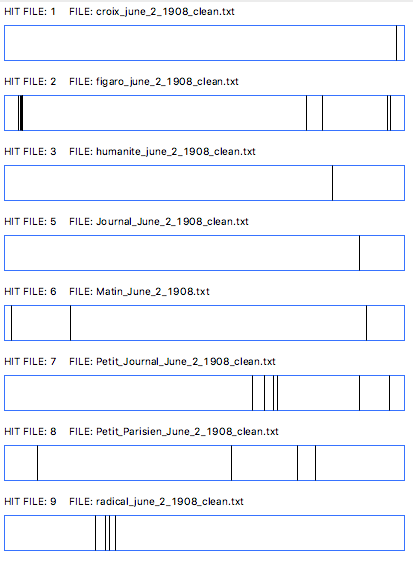
This image was created in Antconc. Anthony, L. (2014). AntConc (Version 3.4.4) [Computer Software]. Tokyo, Japan: Waseda University. Available from http://www.laurenceanthony.net/
The lines show where the question marks not used in dialog are placed in the articles, with the left of the horizontal bar representing the beginning of the article and the right representing the end. On June 2, such question marks often appear at the end of the articles – the doubts were there, but buried. Le Figaro, of course, is an exception, but as discussed above, this paper was both asserting doubt and denying the importance of pursuing such questions.
What we are seeing here is a lot like the “horrible”/”terrible” shift. On June 1, most reporters were expressing confidence that the solution to the mystery of the crime would soon be resolved within the ordinary course of things. On June 2, the press was not so sure. The answer was far less knowable and Mme Steinheil’s account was unreliable at best. But if reporters were suspicious that she was intentionally misleading the public, these doubts were largely expressed in subtle ways. Fundamentally, they were not willing to challenge her statements — or indeed the larger worldview that maintained that only the poor behaved immorally.
Reminder: here’s more on the details of the Steinheil Affair and the newspapers. Bibliography and acknowledgements are here.
Image credits
Figure 3.1: Jerome Robbins Dance Division, The New York Public Library. “Valse chaloupée. “The Apach’s dance,”” New York Public Library Digital Collections. Accessed July 25, 2017. http://digitalcollections.nypl.org/items/a9092220-bb8b-0132-74d7-58d385a7bbd0
Figure 3.2: courtesy of Wikimedia Commons, {{PD-1923}}, available at http://gallica.bnf.fr/ark:/12148/btv1b69129604/
Figure 3.3: Art and Picture Collection, The New York Public Library. “Woman playing the piano.” New York Public Library Digital Collections. Accessed July 26, 2017. http://digitalcollections.nypl.org/items/510d47e3-3388-a3d9-e040-e00a18064a99
Figure 3.4: courtesy of Wikimedia Commons, {{PD-1923}}, available at https://commons.wikimedia.org/wiki/File:Le_Petit_Journal_-_Apache.jpg
Figure 3.5: courtesy of Wikimedia Commons, {{PD-1923}}, originally from Images of hysterics under hypnosis at Salpêtrière, from D.M. Bourneville and P. Régnard, available at https://commons.wikimedia.org/w/index.php?curid=7931810